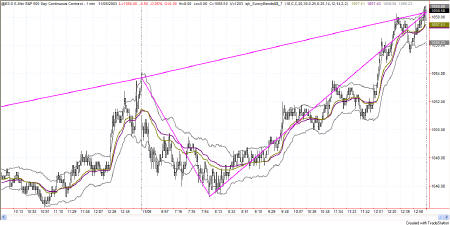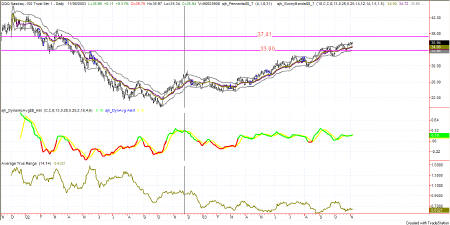
The Sunny Side of the Street
TECHNICAL ANALYSIS EDUCATION: EXPLAINED AND DECIPHERED FOR NEW AND
VETERAN TECHNICAL ANALYSTS ALIKE.
WEDNESDAY EVENING -
Nov 05, 2003
Archives of Past
Commentaries . How Did We Do?
Weekend Stock Picks --
CLICK HERE
| Anyone interested in posting comments or questions to the bulletin board may click here. Sunny personally answers each question or comment posted. | ||
|
|
Yet another day with TradeStation not working. So, here's my commentary without indicators, using charts from Yahoo Finance. |
$66,989 in Stock Picks to date! Click Here to view.

Figure 1: QQQ 01 minute
Today was shaped just about like yesterday, but not nearly so volatile. Again, the pattern is an up and a down, not necessarily in that order, with a net overall of a small move upward.
For short-term traders, there was a beautiful short trade from the opening until 8:08amPT, followed by a long trade for the remainder of the day. The short trade bounced beautifully off of the Attractor I had drawn in 2 days ago at 35.36, which is the lower magenta line on the chart above. There was a little hesitation midday around the middle Attractor at 35.56, almost retracing to the line, but not quite. That in itself was a show of strength and a hint that the market was going to continue its climb upward. The finish today was sharp, like yesterday's, with the run from the middle Attractor upward being stronger than the action of the rest of the day.
The EMini showed the same pattern as the QQQ, with its bounce happening just a few minutes earlier than that of the QQQ, but the same overall tactic for the day: a short early in the morning followed by a long trade for the remainder of the day.
How do you know that? Well, let's look at the Sunny_Bands for the 1-minute chart of the E-Mini.

Figure 3: 1 minute EMini with Sunny_Bands.
In the morning first thing, the ES opened underneath the Sunny_Band midline. That's a signal to get short. The daily Average True Range is about 10 points, making the hourly ATR about 1.5 points. So, when I see 1.5 points of profit, I start watching carefully to protect those profits. Also, if price closes above the Sunny_Band midline you want to take profits. Therefore, you get short at 1050 and take profits at 1047.50, which is more than the hourly ATR. Don't get greedy.
Price closes above the Sunny_Band midline at 7:37amPT, and you get long for 14 bars, until price closes touching the lower band. You take the loss and get short at 1046.75. Again, we are in for a loss, as price closes above the Sunny_Band at 8:30amPT and you get long at 1047.25. On a closing basis, price doesn't touch the lower Sunny_Band again until 11:42, at which time you get out at 1051 for a good profit, and get short. Only a few minutes later, you get whipsawed again, take the loss and go long once more at 1052.75, looking for 1.5 points or more. At 12:43 price touches the midline, and price has been more than generous, giving us a profit of 3 points, and we take it. For me, it's close enough to the end of the day to call it quits at that point. For you, you might want to play out the remainder. If so, you get short and whipsawed again on the crossing of the midline Sunny_Band, and get long again at 13:02. From there you ride the move up to the close at 1058.50 for another 1.5 points profit and get out to close the trade. If you are not risk averse, you ride the market overnight in the long position and wait to see what tomorrow brings.
On the daily chart, the view is a bit different, but we read it just the same.
On the daily chart in figure 4, the QQQ is the same as the ES. Both have been in the upper part of the bands for 7 days now, and that's all you do. You go long when price crosses the band and stay there until it closes the other direction, or until you capture 1 ATR of profit. On the QQQ weekly chart, one ATR of profit amounts to $1.60, so I would take profit on the daily chart after seeing 1 ATR of profit, or after the market turned back down into the midline, which ever is later.
For tomorrow, it once again looks like we will have the same kind of day: up and down. As I've said previously, it looks like the QQQ is making a run for 37.41, and I expect this run to continue for a while longer.
Keep your senses about you and use strict discipline in trading.
Trading is a risky business.
Attractor: a level to which prices seem to be drawn, like a magnet. Usually these are lines of support or resistance from previous highs and lows, but can also be an important level on an indicator, or the edge of a Sunny_Band.
PHW: Potential Hourly Wage. A term coined by Sunny to examine whether trading for a living is really worth it when compared to the minimum wage standard. Before considering a trading system to be a success, it should pass the PHW test.
RSI: Relative Strength Index (TradeStation function)
SDMA: Sunny's Dynamic Moving Average (proprietary)
Shooting Star: A candlestick pattern discussed further under Reference, Candlesticks.
SDMA_Hst: Sunny's Dynamic Moving Average presented in a histogram format where the line representing the difference between the two SDMA lines turns from red to green when the two SDMA lines cross each other (the difference is zero). The yellow line is an average of the histogram line.
Sunny_Band: Sunny's Dynamic Moving Average plus 1.5 ATR and minus 1.5 ATR, creating a band on either side of the SDMA.
Vehicles: Trading symbols. IBM is an equity vehicle; SPU03 is the SP futures contract that expires in Sept of 2003; @ES.D is the EMini; mutual funds are vehicles; gold is a trading vehicle; etc.
This commentary is meant only for EDUCATIONAL PURPOSES. It is to help you see how a Technical Analyst reads the signs in the markets.
Stay sharp and on your toes. Moves can reverse on a dime, anytime. Let the market speak to you. If the market is going down, by golly ignore my commentary from the night before and know that the market is going down.
RULES OF THUMB:
0. I keep the chart in Figure 1a on each day's commentary simply to illustrate how much in tandem the 4 indexes I watch actually are. For this reason, I don't always comment on every index. Analysis of one speaks highly for the same analysis for each of the other indexes.
1. When price is pushing the upper Sunny_Bands upward and then eases off and moves back toward the midline, it's time to take profits. If it starts moving up and pushing on the Sunny_Bands again, it's time to get back in. Likewise, if the market is pushing down on the lower Sunny_Band and eases off to move back to the midline, it's time to take profits from the short play.
2. Divergence of the RSI and price is another good time to take profits and wait for a breakout of price before taking a position.
3. When the exchange puts in curbs or trading halts on a large move down, it usually (not always) stops the downward motion. After the market reopens is a good time to take profits from your short position.
4. The market can't go nowhere forever. Eventually, who knows how long it will be, there will have to be a breakout-- one direction or the other.
5. This commentary is for educational purposes only, and is meant only to teach readers about my indicators, other technical indicators, and how I read them.
==<:>==
While it may be true that a picture is worth a thousand words, it is definitely not true that a picture deserves a thousand words.

